All About Computer Numerically Controlled Machine Tool Programmers
Occupation Description Develop programs to control machining or processing of metal or plastic parts by automatic machine tools, equipment, or systems.
What Do Computer Numerically Controlled Machine Tool Programmers Do On a Daily Basis?
- Write programs in the language of a machine’s controller and store programs on media such as punch tapes, magnetic tapes, or disks.
- Align and secure pattern film on reference tables of optical programmers, and observe enlarger scope views of printed circuit boards.
- Compare encoded tapes or computer printouts with original part specifications and blueprints to verify accuracy of instructions.
- Prepare geometric layouts from graphic displays, using computer-assisted drafting software or drafting instruments and graph paper.
- Write instruction sheets and cutter lists for a machine’s controller to guide setup and encode numerical control tapes.
- Perform preventative maintenance or minor repairs on machines.
Featured schools near , edit
Qualities of a Computer Numerically Controlled Machine Tool Programmer
These are the skills Computer Numerically Controlled Machine Tool Programmers say are the most useful in their careers:
Programming: Writing computer programs for various purposes.
Monitoring: Monitoring/Assessing performance of yourself, other individuals, or organizations to make improvements or take corrective action.
Operation Monitoring: Watching gauges, dials, or other indicators to make sure a machine is working properly.
Reading Comprehension: Understanding written sentences and paragraphs in work related documents.
Mathematics: Using mathematics to solve problems.
Critical Thinking: Using logic and reasoning to identify the strengths and weaknesses of alternative solutions, conclusions or approaches to problems.
Related Job Titles for this Occupation:
- Computer Numerical Control Programmer (CNC Programmer)
- Metal Numerical Tool Programmer
- Process Engineer
- Numerical Tool Programmer
- Computer Numerical Control Process Control Programmer (CNC Process Control Programmer)
What Kind of Computer Numerically Controlled Machine Tool Programmer Job Opportunities Are There?
There were about 25,100 jobs for Computer Numerically Controlled Machine Tool Programmer in 2016 (in the United States). New jobs are being produced at a rate of 16.3% which is above the national average. The Bureau of Labor Statistics predicts 4,100 new jobs for Computer Numerically Controlled Machine Tool Programmer by 2026. Due to new job openings and attrition, there will be an average of 3,100 job openings in this field each year.
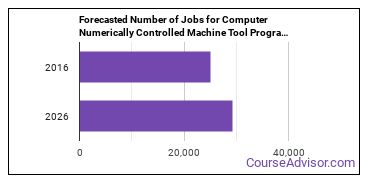
The states with the most job growth for Computer Numerically Controlled Machine Tool Programmer are Utah, Nevada, and South Dakota. Watch out if you plan on working in Washington, Vermont, or Maryland. These states have the worst job growth for this type of profession.
Salary for a Computer Numerically Controlled Machine Tool Programmer
Computer Numerically Controlled Machine Tool Programmers make between $33,870 and $83,330 a year.
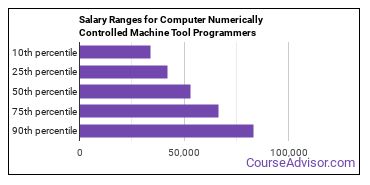
Computer Numerically Controlled Machine Tool Programmers who work in California, Connecticut, or Massachusetts, make the highest salaries.
How much do Computer Numerically Controlled Machine Tool Programmers make in different U.S. states?
| State | Annual Mean Salary |
|---|---|
| Alabama | $45,620 |
| Arizona | $59,550 |
| Arkansas | $55,220 |
| California | $66,560 |
| Colorado | $49,040 |
| Connecticut | $65,560 |
| Florida | $53,780 |
| Georgia | $49,990 |
| Idaho | $45,030 |
| Illinois | $54,900 |
| Indiana | $49,490 |
| Iowa | $46,070 |
| Kansas | $59,350 |
| Kentucky | $47,230 |
| Louisiana | $47,430 |
| Maine | $48,260 |
| Maryland | $61,850 |
| Massachusetts | $65,150 |
| Michigan | $52,150 |
| Minnesota | $61,000 |
| Mississippi | $43,170 |
| Missouri | $55,050 |
| Nebraska | $48,870 |
| Nevada | $58,310 |
| New Hampshire | $59,730 |
| New Jersey | $55,980 |
| New York | $55,720 |
| North Carolina | $46,940 |
| Ohio | $52,800 |
| Oklahoma | $54,320 |
| Oregon | $59,780 |
| Pennsylvania | $55,680 |
| Rhode Island | $54,190 |
| South Carolina | $51,870 |
| South Dakota | $50,810 |
| Tennessee | $53,640 |
| Texas | $58,660 |
| Utah | $47,440 |
| Vermont | $55,280 |
| Virginia | $52,870 |
| Wisconsin | $51,260 |
What Tools & Technology do Computer Numerically Controlled Machine Tool Programmers Use?
Although they’re not necessarily needed for all jobs, the following technologies are used by many Computer Numerically Controlled Machine Tool Programmers:
- Microsoft Excel
- Microsoft Word
- Microsoft Office
- Microsoft PowerPoint
- Autodesk AutoCAD
- Extensible markup language XML
- Computer aided design CAD software
- Dassault Systemes CATIA
- Dassault Systemes SolidWorks
- Enterprise resource planning ERP software
- PTC Creo Parametric
- Computer aided manufacturing CAM software
- 1CadCam Unigraphics
- G code
- Mastercam
- Vero Software SURFCAM
- M code
- DP Technology ESPRIT
- Aptean Made2Manage
- SmartCAMcnc SmartCAM
Becoming a Computer Numerically Controlled Machine Tool Programmer
What kind of Computer Numerically Controlled Machine Tool Programmer requirements are there?
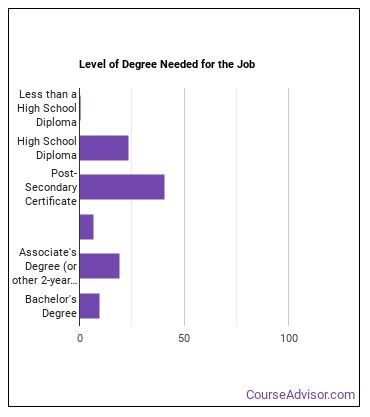
How Long Does it Take to Become a Computer Numerically Controlled Machine Tool Programmer?
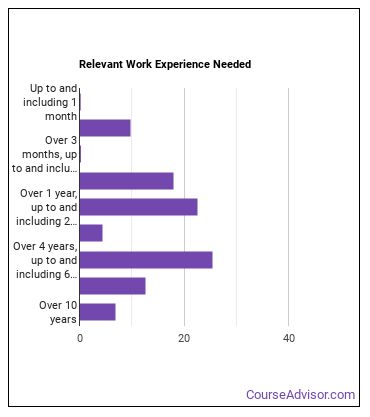
Who Employs Computer Numerically Controlled Machine Tool Programmers?
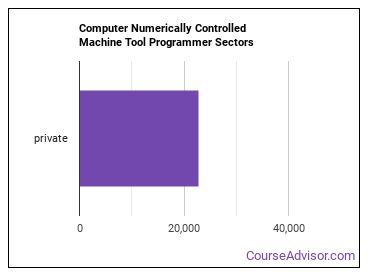
The table below shows the approximate number of Computer Numerically Controlled Machine Tool Programmers employed by various industries.

Similar Careers
Those interested in being a Computer Numerically Controlled Machine Tool Programmer may also be interested in:
Are you already one of the many Computer Numerically Controlled Machine Tool Programmer in the United States? If you’re thinking about changing careers, these fields are worth exploring:
References:
Image Credit: US Air Force photo/Airman 1st Class John Linzmeier via Public domain
More about our data sources and methodologies.
Featured Schools
 Request Info
Request Info
|
Southern New Hampshire University You have goals. Southern New Hampshire University can help you get there. Whether you need a bachelor's degree to get into a career or want a master's degree to move up in your current career, SNHU has an online program for you. Find your degree from over 200 online programs. Learn More > |
